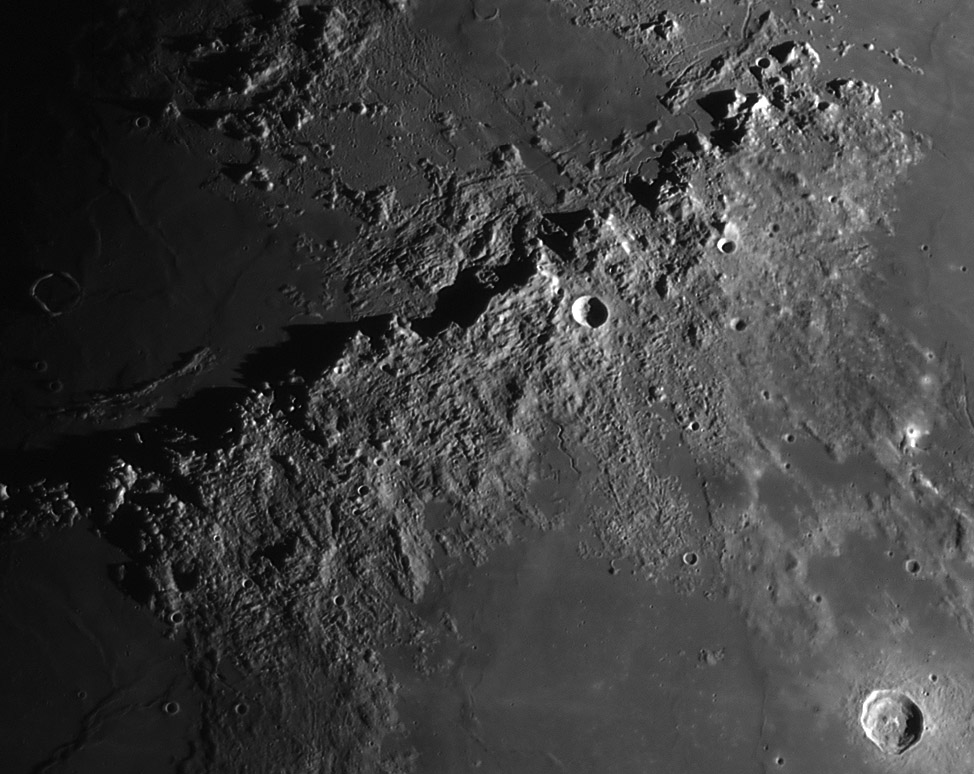LPOD Feb 21, 2008
A CHANGE IN TEXTURE

image by Joseph M Zawodny, Poquoson, VA
The Apennines are a major mountain range - 500 km long, up to about 150 km wide. They are the best developed part of the Imbrium Basin rim, uplifted country rock coated with piles of ejecta. In previous LPODs I have been fascinated by the offsets of the Apennine Front and the linear features that cut the mountains. In this piece from Joe's pole to pole mosaic another characteristic of the Apennines is clear. There is a gradual change in texture of the mountains, from the western scarp toward the eastern foothills. Much of the area is rugged with many isolated bright peaks. This is rubble, but each block is a few kilometers wide - each is a small mountain. Some places have a sense of swirled texture, like a knife smoothing cake frosting. But the surface isn't smoothed at all - the frosting contained lots of nuts and other fragments. In general the mountains get smaller away from the scarp - if they are mostly pieces of ballistic ejecta the bigger ones fell out before the smaller ones. But if they are ejecta why didn't each make a secondary crater - certainly further away similar blocks did. So perhaps they were emplaced as ejecta which were blasted across the surface - probably at 100s of meters/sec - a hurricane of mountains. There is another apparent change of texture of the Apennines - the northern end looks smoother with few bright peaks. Partly that is real, but look closely and notice the boundary is very sharp and nearly vertical - the rightmost piece of the mosaic apparently had worse seeing than the rest - that change in texture is an artifact!
Chuck Wood
Note: I took a break from writing this Wednesday night and, miracle of miracles, the clouds are gone and the Moon is nearly fully eclipsed, with only a narrow piece of full Moon brightness left along the SE limb! I hope you got to see some of the red Moon yourself.
Technical Details
FEB 14, 2008, ~ 6:00 pm EST. Celestron 11" + TIS DMK31AF03.AS. Image excerpted from a pole to pole mosaic, best 100 of 1300 stacked images.
Related Links
Rükl plate 22
SOMETHING NEW!
To post comments regarding this LPOD, please click here and enter your text just below the word "Comments". Perhaps if comments are more visible, there will be more of them! You will not see the Edit tab unless you register for the wiki. Please do not edit the LPOD itself!
COMMENTS
1) I did get some of the red Moon! It was beautifull!
http://lunainjaz.spaces.live.com/photos/cns!96EA3F49744A1299!335/
2) It is interesting to note that the larger crater in the image, Conon, is about 13 miles in diameter and about 7,500 feet deep. The rille to the southwest of the crater must be about 30 miles long. (??) These sinuous rilles look amazingly like riverbeds. I assume the rille formed after the Apennines were created and that it is connected to lavas from Mare Vaporum. (??)
--Bill
3) It was thought 50 or more years ago that sinuous rilles were water rivers, but they are lava rivers. The lava was erupted after the Apennines formed - and the sinuous rille was probably one of the sources of lava - the rille didn't cut the pre-existing lava but deposited it.
4) Oops. I should have noted that Conon is the crater in the Apennines. I believe the larger crater to the southeast is Manilius. (??)
--Bill